Drink-driving rules could be about to get TOUGHER: British Medical Association will campaign to lower legal blood alcohol limit by a third
- The British Medical Association wants the level cut by more than a third
Doctors will lobby the government to slash the drink drive limit from the highest in Europe amid claims it is fuelling hundreds of avoidable road deaths each year.
The British Medical Association wants the level cut by more than a third to bring England, Wales and Northern Ireland into line with the continental average.
It would mean many motorists are effectively banned from consuming any alcohol before getting behind the wheel, in a blow to the hospitality industry.
Representatives at the BMA's annual conference backed a motion that commits the union to campaigning to 'reduce the legal blood alcohol limit to the average of European Nations'.
The current level in England, Wales and Northern Ireland is 80 milligrammes of alcohol per 100 millilitres of blood.

The BMA aims to campaign to bring down the drink-drive limit (Liam McBurney/PA)
Malta is the only other European country to have a limit this high, with Scotland and much of Europe setting a level of 50 milligrammes.
Some nations set the bar even lower.
The RAC website warns there is 'no hard and fast rule' for how many units of alcohol a person can safely drink without exceeding the 80 milligrammes limit as it depends on the individual's gender, age, weight, metabolism, stress levels and food intake.
However, it says this is likely to be no more than two to three units of alcohol for men and no more than one to two units for women.
This is equivalent to one pint of beer (2.3 units) or one small glass of wine (1.6 units).
Sir Ian Gilmore, president of the BMA, told delegates at the conference in Liverpool: 'It's scandalous that two countries in Europe have a level of 80 milligrams - Malta and the UK.
'The level to which we reduce it is I think up for debate.
'My preference is to go down to 20 milligrams. It allows for almost zero tolerance but takes account of a pretty strong aftershave that morning.'
In Scotland, the alcohol drink-driving limit was cut to 50 milligrams of alcohol in every 100 millilitres of blood in 2014.
Christopher Snowdon, head of lifestyle economics at the Institute of Economic Affairs, warned reducing the limit in England, Wales and Northern Ireland would result in the closure of more pubs.
He said: 'Scotland lowered the drink driving limit several years ago.
'It was predicted to reduce traffic accidents and road deaths but subsequent evaluations showed that it did nothing but damage the pub trade.
'The BMA's new president, Ian Gilmore, is Britain's leading temperance activist so he won't mind if more pubs close, but he gives the game away when he says he wants the limit reduced to almost nothing.
'This would not just stop people drinking anything before they drive, it would discourage them from drinking in the evening if they were going to drive in the morning.
'It is an anti-alcohol policy, not a road safety policy.'
Data from the World Health Organisation suggests that drivers with between 20 to 50 milligrams of alcohol per 100 millilitres of blood are three times more likely to die in a crash than those who have not consumed any alcohol.
The Drinkaware website warns that drinking alcohol 'slows down your reactions and impairs judgement, making your driving unsafe and putting you, and others, at greater risk of accidents'.
It adds: 'Even small amounts of alcohol can affect your ability to drive, and there is no fool-proof way to drink and stay within the limit.
'The advice from the police is clear: avoid alcohol altogether if you plan to drive.
It says there is no way to speed up how long a person's body takes to process alcohol so there is no 'fail-safe' way to guarantee it will be gone the following morning.
There were 85,410 casualties as a result of drink drive collisions in Britain between 2011 and 2020, according to the most recent figures from the Department for Transport.
There were also an estimated 2,320 deaths and 15,540 serious injuries over the decade.
Fewer than four in ten (38 per cent) motorists involved in collisions are now breath tested, down from 54 per cent a decade earlier.
And the number of breath tests conducted following a collision has more than halved over this period from 138,650 to 58,536.
The motion, proposed by the BMA's North West Regional Council, also commits the union to campaign to educate the public on the risks of drink and drug-driving, improve the provision of drug and alcohol services in the community and remind doctors of current professional guidelines relating to driving.
Dr Katherine Severi, chief executive of the Institute of Alcohol Studies, said: 'We've been calling for many years for a reduction in the drink drive limit.
'It is nonsensical that the UK - excluding Scotland - has the unenviable title of having the highest limit in Europe.
'Again, Scotland leads the way in introducing alcohol control policies, as it reduced its limit almost a decade ago.
'Thousands of people every year suffer life-changing injuries due to drink driving, and around 220 people die.
'As with many deaths related to alcohol, these are avoidable.
'If the rest of the UK were aligned with Scotland with a limit of 50mg alcohol/100ml blood, evidence suggests it would lead to an 11 per cent reduction in fatal alcohol-related crashes.
'It should not be seen as acceptable to consume a drug and then operate the most dangerous piece of machinery that most of us have access to.'
Responding to the vote result, Professor David Strain, chair of the BMA's board of science, said: 'Doctors are primarily concerned with saving lives, and protecting and improving people's health.
'While the direct risk that alcohol poses to people's health is clear, the indirect harms stretch much further – not least when someone decides to get behind the wheel after drinking, sometimes with lethal consequences.
'With the exception of Scotland, when we look at our contemporaries across Europe, the UK has a higher threshold for the drink-drive limit which makes no sense.
'It's not as if when we cross borders that the body suddenly reacts differently to alcohol.
'Meanwhile, the public focus should not be limited just to drinking, but to any substance – whether legal or illegal – that alters cognitive and neurological functions, and therefore the capability to drive.
'This resolution underlines the BMA's dedication to improving and protecting the health of the public and commitment to a safer and healthier society.'









































































































































































































































